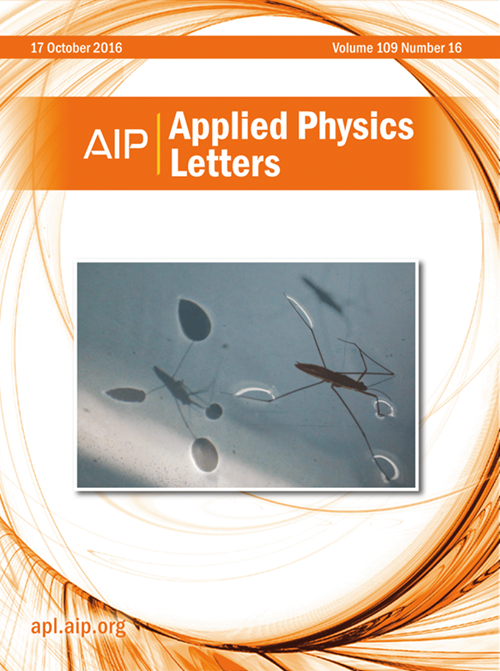通过磁场调制实现外延p-GeFeTe/n-Si异质结的超低阈值电压
IF 3.5
2区 物理与天体物理
Q2 PHYSICS, APPLIED
引用次数: 0
摘要
结合相变材料(PCMs)的异质结构二极管结构最近成为下一代相变随机存取存储器(PCRAM)技术的有力候选者。然而,p-n异质结构的导通阈值电压(Vth)与相变电压(Vpc)之间的接近导致工作电压窗口非常窄,严重限制了器件的可靠性。在这项研究中,我们提出了通过磁场介导控制Vth的外延p-GeFeTe/n-Si异质结工程的突破。p-GeFeTe/n-Si异质结表现出指数电流密度-电压(J-V)行为,Vth为0.95 V。对半对数ln(J) -V曲线的分析揭示了三个不同的线性区域,每个区域都具有不同的理想因子(ηd1, ηd2和ηd3)。随着磁场强度(H)的增加,这些理想因子之间的差异逐渐减小,最终在H = 45 kOe处收敛为一个单一的线性区域。在这个磁场下,实现了0.27 V的超低电压,与没有磁场的操作相比,降低了72%。这种磁响应的J-V行为归因于自旋分裂带结构,该结构诱导了场调制半导体到半金属的相变,正如带对准模型所解释的那样。这些发现为扩大PCRAM的工作电压窗口提供了可行的策略,并为多功能pcm器件铺平了道路。本文章由计算机程序翻译,如有差异,请以英文原文为准。
Ultralow threshold voltage in an epitaxial p-GeFeTe/n-Si heterojunction enabled by magnetic field modulation
Heterostructure diode architectures incorporating phase change materials (PCMs) have recently emerged as strong candidates for next-generation phase change random access memory (PCRAM) technology. However, the close proximity between the turn-on threshold voltage (Vth) of p-n heterostructures and the phase change voltage (Vpc) results in a critically narrow operational voltage window, significantly limiting device reliability. In this study, we present a breakthrough in epitaxial p-GeFeTe/n-Si heterojunction engineering through magnetic field-mediated control of Vth. The p-GeFeTe/n-Si heterojunction exhibits exponential current density–voltage (J–V) behavior with a Vth of 0.95 V. Analysis of the semilogarithmic ln(J)–V curve reveals three distinct linear regions, each characterized by a different ideality factor (ηd1, ηd2, and ηd3). As the magnetic field strength (H) increases, the differences among these ideality factors diminish, ultimately converging into a single linear region at H = 45 kOe. Under this magnetic field, an ultralow Vth of 0.27 V is achieved—representing a 72% reduction compared to operation without a magnetic field. This magneto-responsive J–V behavior is attributed to spin-split band structures that induce a field-modulated semiconductor-to-half-metal phase transition, as explained by a band alignment model. These findings offer a viable strategy for widening the operational voltage window of PCRAM and pave the way for multifunctional PCM-based devices.
求助全文
通过发布文献求助,成功后即可免费获取论文全文。
去求助
来源期刊

Applied Physics Letters
物理-物理:应用
CiteScore
6.40
自引率
10.00%
发文量
1821
审稿时长
1.6 months
期刊介绍:
Applied Physics Letters (APL) features concise, up-to-date reports on significant new findings in applied physics. Emphasizing rapid dissemination of key data and new physical insights, APL offers prompt publication of new experimental and theoretical papers reporting applications of physics phenomena to all branches of science, engineering, and modern technology.
In addition to regular articles, the journal also publishes invited Fast Track, Perspectives, and in-depth Editorials which report on cutting-edge areas in applied physics.
APL Perspectives are forward-looking invited letters which highlight recent developments or discoveries. Emphasis is placed on very recent developments, potentially disruptive technologies, open questions and possible solutions. They also include a mini-roadmap detailing where the community should direct efforts in order for the phenomena to be viable for application and the challenges associated with meeting that performance threshold. Perspectives are characterized by personal viewpoints and opinions of recognized experts in the field.
Fast Track articles are invited original research articles that report results that are particularly novel and important or provide a significant advancement in an emerging field. Because of the urgency and scientific importance of the work, the peer review process is accelerated. If, during the review process, it becomes apparent that the paper does not meet the Fast Track criterion, it is returned to a normal track.
 求助内容:
求助内容: 应助结果提醒方式:
应助结果提醒方式:


